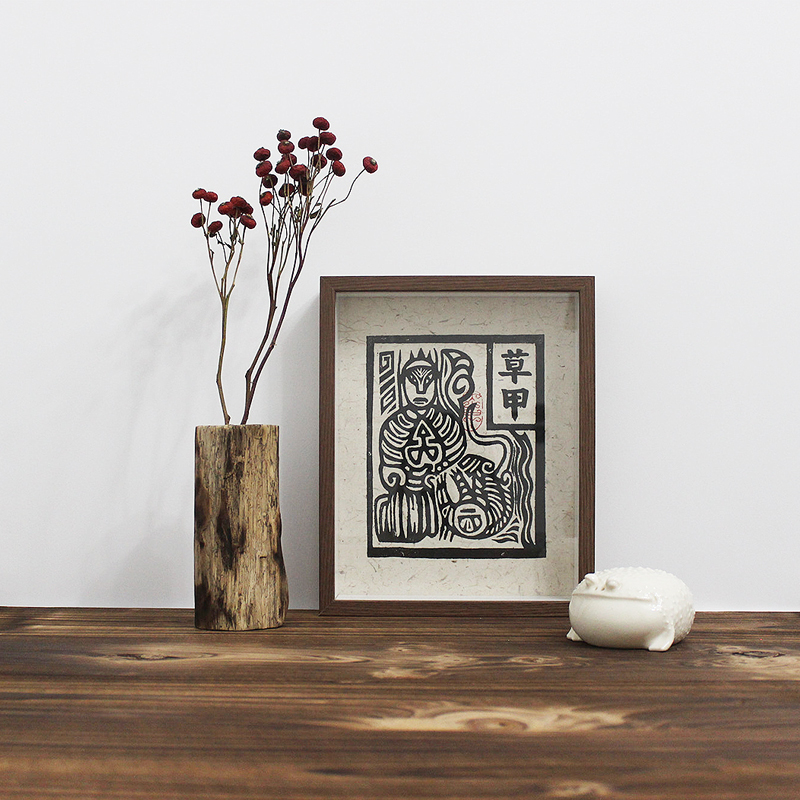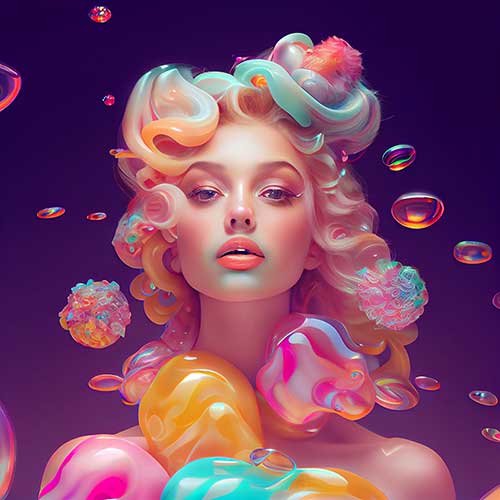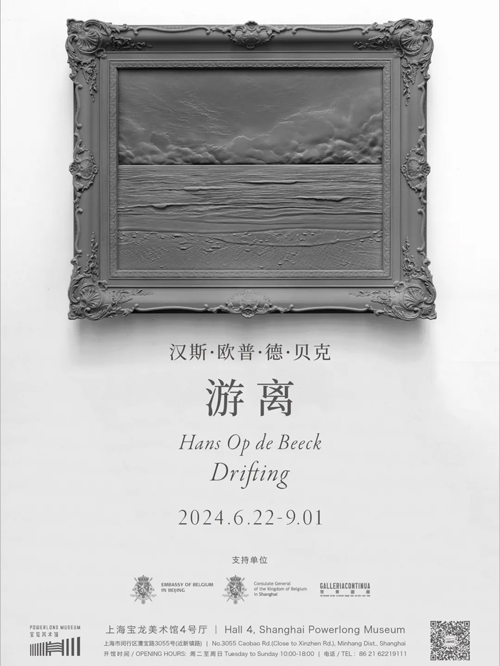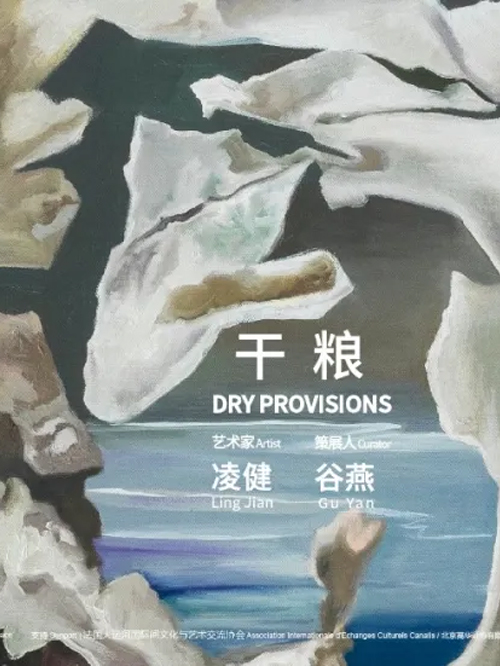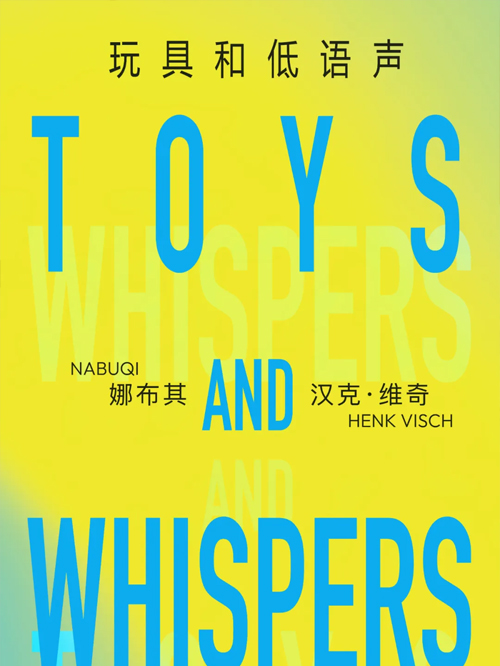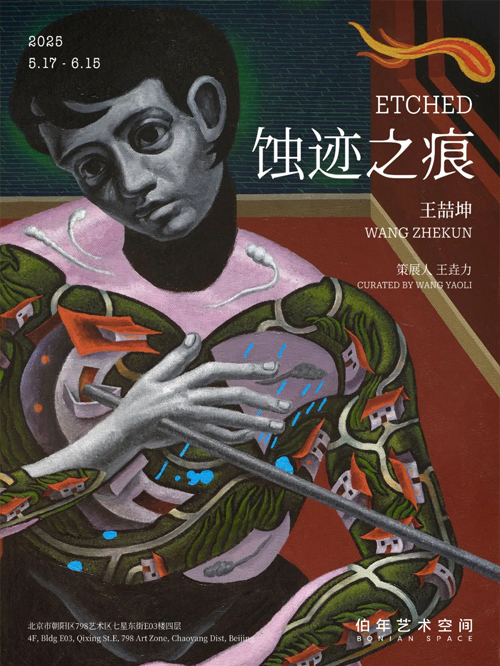汉斯·欧普·德·贝克(Hans Op de Beeck)是当代艺术领域的代表性艺术家。过去的十年间,他利用不同媒材创作了大量作品,包括装置、影像、文本、绘画、摄影和绘画。同时,他还在戏剧、歌剧和当代舞蹈领域担任剧作、舞台导演、布景设计和服装设计。汉斯最为人熟知的是体量宏大的沉浸式装置。他打造出仿佛冻结时间的神秘场景,邀请观众步入沉默的冥想空间激发出奇妙的感官体验。他的作品深入探讨了人类与环境间的复杂关系,探寻关于生命意义的普遍问题。
展览的标题“游离(Drifting)”概括了心理和身体的漂浮,以及屈服于命运和自然等不可控制力量的主题。对于艺术家而言,他还象征着注意力的无意识漂移,类似于白日梦,和做梦时的状态近似,也象征着意识与现实世界的脱离。这是他作品中反复出现的主题,意在邀请观众拥抱他们自身的梦境与想象。而在此次展览中,“游离”也意在探讨衰变与死亡,将观众带入更深的体验。
展览“游离”全方面探索了汉斯·欧普·德·贝克多方面的艺术实践,其中包括两个主要部分:一个是影像放映室,另一个是传统的绘画室。影像放映厅展出他的最新动画电影《灭点(Vanishing Poin)》(2023-2024),观众将被带入汉斯所创造的富有感染力和沉浸感的世界;绘画室则展出艺术家一系列近期创作的雕塑和水彩作品,为观众呈现出他作品的多样性与内在联系。
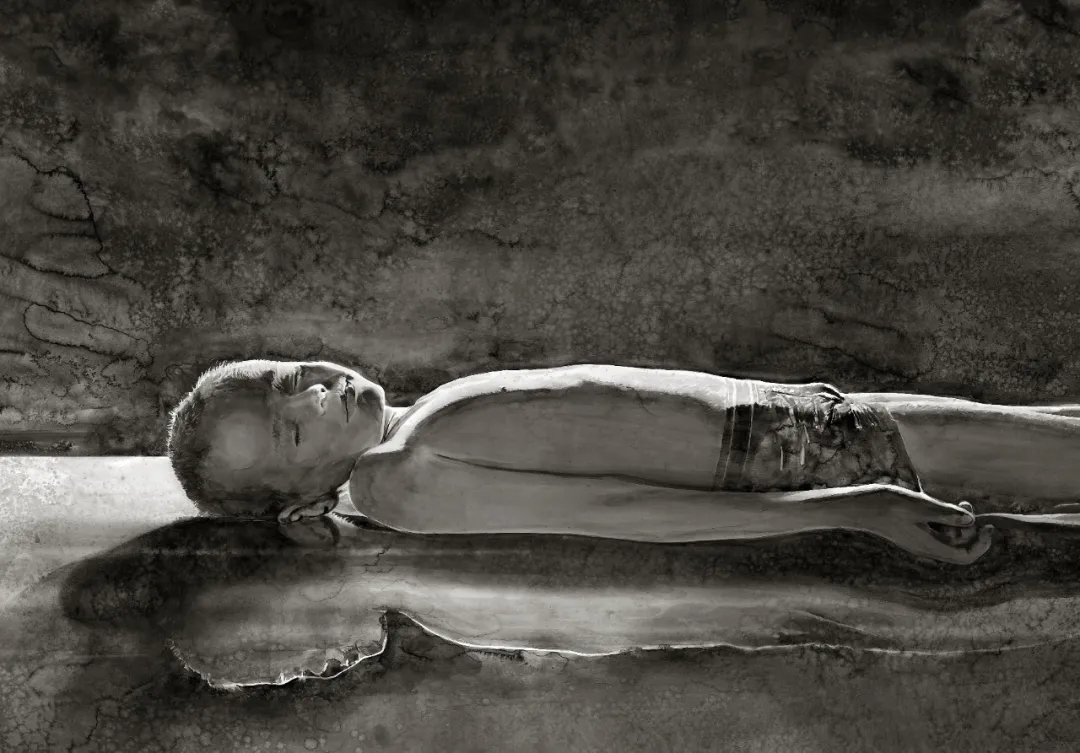
灭点 影像 2023 ©️艺术家与常青画廊
展览的亮点之一即是汉斯创作的动画电影《灭点》,作品深入讨论“消失点”的隐喻和哲学概念:平行线汇聚,象征着可观测理解的事物,逐渐转变成不可理解的抽象未知。探讨了人类的自我迷失、永恒与转瞬即逝等主题。在宁静的水彩画面中,影片从一个休息中的男孩开始,随后过渡到生动的虚构景观和人物,伴随着由萨姆·弗洛曼斯(Sam Vloemans)作曲,赫尔墨斯合奏团(Hermes Ensemble)演奏的独特音乐,作品邀请观众体验“放下”的瞬间,在沉思中感受个人面对宇宙乃至永恒的微不足道,同时也突出生命中微小而重要的时刻,亦有其光辉与意义。
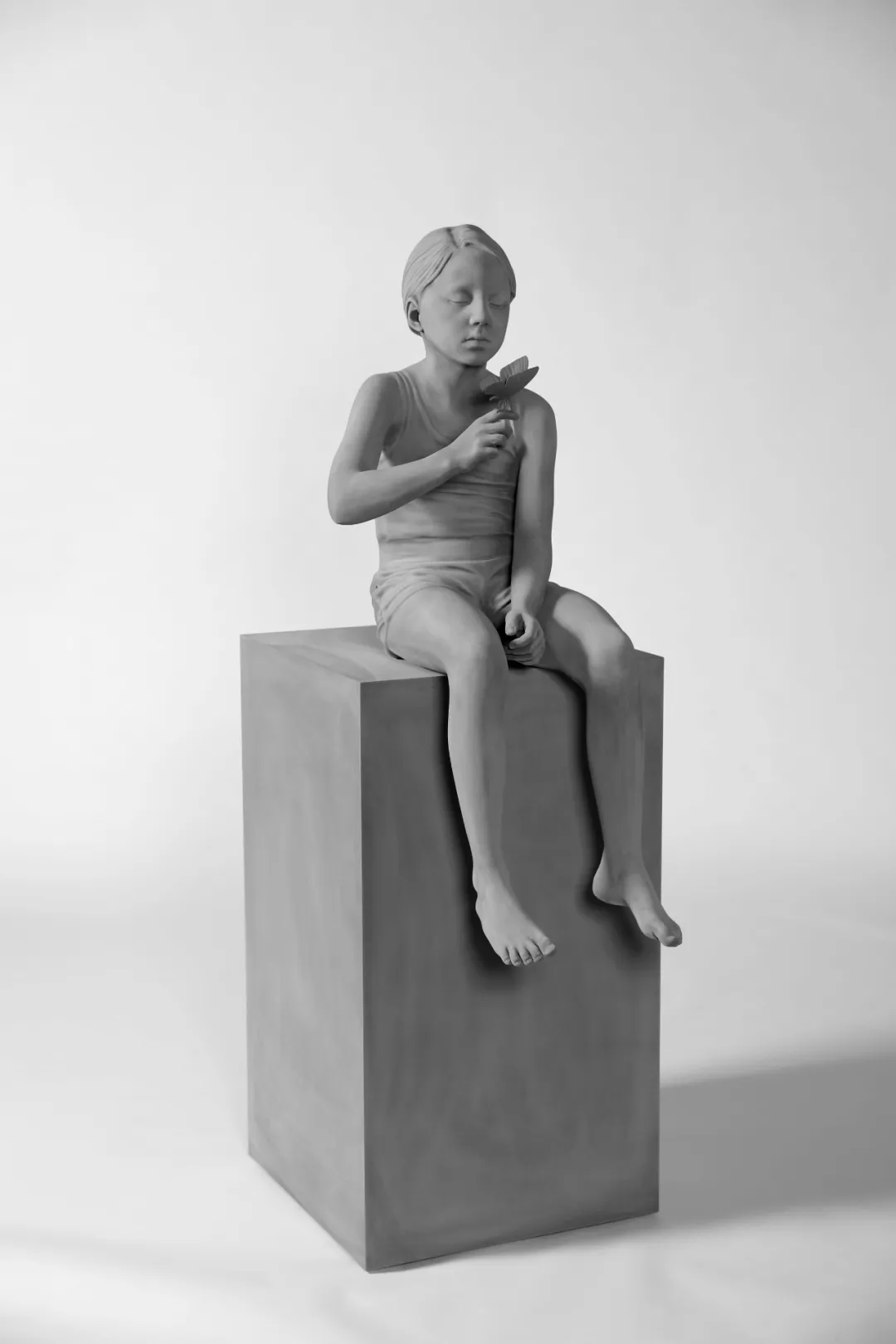
塔提亚娜(蝴蝶)156x79x50cm 综合材料 2017 ©️艺术家与常青画廊
绘画室展出了作品《塔提亚娜(蝴蝶)Tatiana (butterfly)》(2017)。这一艺术家近期作品中出现的真人大小的灰色单色人物,标志着他的艺术创作从过去关注空旷空间转变为细致的人物形象塑造,主要为儿童和年轻人。这些精心塑造的人物雕像栩栩如生,却紧闭双眼,沉浸在自我与当下的瞬间,游离于观众之外。如水晶球冥想的“布莱恩(Brian)”、玩弹珠或射箭的“提莫(Timo)”,以及感受蝴蝶轻盈的“塔提亚娜(Tatiana)”都展现出——日常的行为因为静止而营造出安静、内省的氛围。
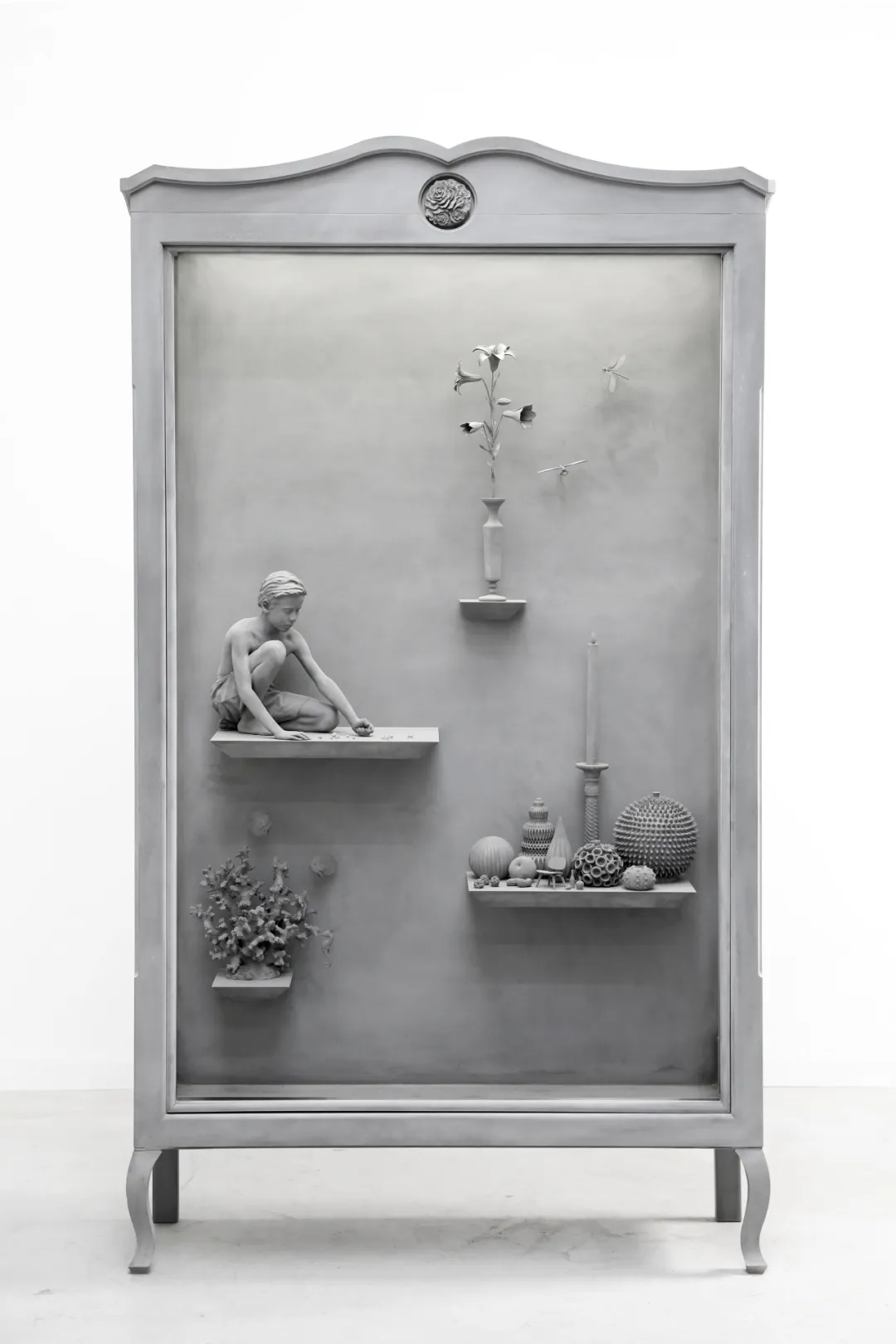
珍奇屋(11)216.5x120x41cm 综合材料 2020 ©️艺术家与常青画廊
《珍奇屋 Wunderkammer(11)》(2020)是汉斯自2018年开始创作的展示柜系列的其中一件。它展示了一位虚构的收藏家收藏的一系列纪念物品,这些纪念品都是灰白色,类似于石化的文物。受欧洲文艺复兴时期的“珍奇屋”和“珍品陈列室”的启发,这些纪念品充斥着强烈的时间错位性,意在探讨有价值、无价值的界定,凸显了时间静止所带给物件的新生,呈现出这些遗留物的寂静之感。
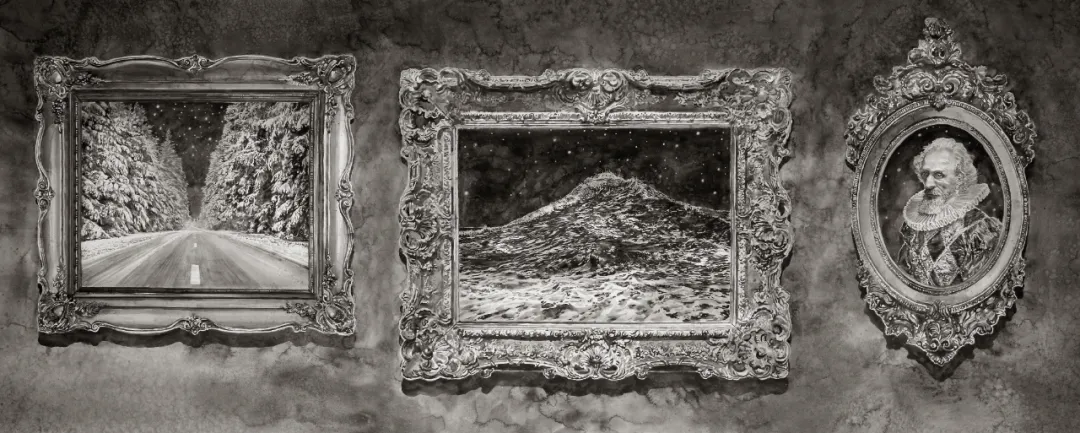
公路、大海与丑角 290x4.5x130cm 水彩 2023 ©️艺术家与常青画廊
最后,展览还呈现了一系列水彩作品,包括《公路、大海和丑角(The Road, the Sea and the Harlequin)》(2023,水彩)。这幅作品将三个虚构的画作图像结合在一起。通过这三幅图像——一个神秘人、一条被雪覆盖的荒路和一片汹涌的大海,可衍生出无数个故事,留给观众自己想象。
Hans Op de Beeck, a prominent figure in contemporary art, has built a significant body of work across various media, including installations, video, texts, drawings, photography, and paintings. In the last decade, he has also contributed to theatre, opera, and contemporary dance as a playwright, stage director, scenographer, and costume designer. Op de Beeck is best known for his monumental, immersive installations that create enigmatic, frozen-in-time scenes, prompting visitors to engage in silent contemplation and experience a sense of wonder. His work delves into the intricate relationship between humans and their surroundings, probing universal questions about life's meaning.
The exhibition’s title, "Drifting",encapsulates themes of mental and physical floating and surrendering to uncontrollable forces like fate and nature. It also signifies the involuntary drift of attention, similar to daydreaming. For Op de Beeck, drifting relates to the states of sleep and dreaming, symbolizing a detachment from the real world. This concept is a recurrent theme in his work, inviting audiences to embrace their dreams and imagination. Drifting, as explored in this exhibition, also touches on the ideas of transition and death, adding layers of depth to the viewing experience.
"Drifting" presents a comprehensive exploration of Hans Op de Beeck’s multifaceted artistic practice, featuring two major components: a projection room and a classic drawing room. Visitors will be transported into Op de Beeck’s evocative and immersive world, where his latest animated film, "Vanishing Point" (2023-’24), will be showcased in the projection room. The drawing room will exhibit a curated selection of recent sculptures and watercolour paintings, providing a diverse yet cohesive look at his work.
One of the centerpieces of the exhibition is "Vanishing Point," an animated film by Op de Beeck that delves into the metaphorical and philosophical notion of the vanishing point, a concept where parallel lines converge, symbolizing a transition from the measurable and comprehensible to the unknown and abstract. The film explores themes of self-loss, timelessness, and the fleeting nature of human existence. It begins with the serene image of a boy at rest and transitions into evocative fictional landscapes and figures, brought to life through tranquil watercolors and a unique musical composition by Sam Vloemans, performed by the Hermes Ensemble. The film invites viewers to experience moments of letting go, reflecting on the insignificance of individuals in the vastness of eternity and the universe, while also highlighting the brilliance and value of life's small, essential moments.
In the drawing room is shown, among others, “Tatiana (butterfly)”(2017). This piece shows the recent emergence of life-sized monochrome grey figures that marks a shift in the artist's work from previously focusing on largely empty spaces to featuring detailed human forms, primarily children and young adults. These figures, though lifelike and meticulously crafted, remain introspective and detached from the viewer, with their eyes closed and absorbed in their own activities. Examples include 'Brian' meditating with a crystal sphere, 'Timo' playing with marbles or shooting a toy arrow, and 'Tatiana' feeling the delicate touch of a butterfly. These ordinary, paused actions create a sense of introspection and quiet reflection.
"Wunderkammer (11)" (2020) is part of Hans Op de Beeck's ongoing series of sculptural display cases, begun in 2018. These pieces feature a variety of keepsake objects imagined by a fictional collector, all crafted in ash-grey to resemble fossilized artifacts. Inspired by the European Renaissance's "Wunderkammer" or cabinets of curiosities, these collections appear anachronistic and diverse in origin. The display cases challenge the distinction between valuable and worthless, highlighting how stories can animate still objects. They present a sense of stripped-down, silent relics, devoid of their original luster.
Finally, the exhibition presents a series of watercolors including 'The Road, the Sea and the Harlequin,' watercolour on paper (2023). This work brings together three images of fictional, framed paintings on a wall. Through free association, possible stories arise between the three images of a mysterious man, a deserted snow-covered road and a raging sea. The interpretation is left to the viewer.
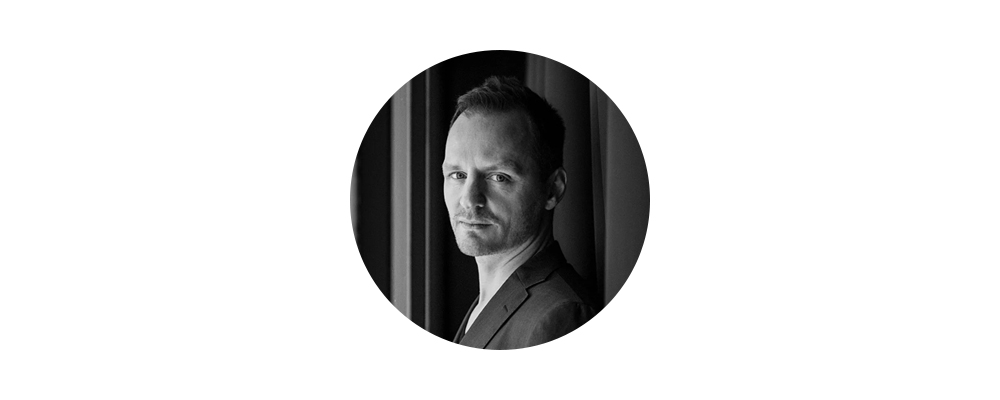
汉斯·欧普·德·贝克
Hans Op de Beeck
比利时视觉艺术家汉斯·欧普·德·贝克1969年出生在特恩豪特市,当前在布鲁塞尔生活和工作。
他的作品多种多样,包括巨形雕塑装置、影像、动画影片、雕塑、绘画、摄影、短篇小说、舞台设计等。他的作品深刻反思了我们身处的复杂社会以及回荡其中有关意义与死亡的宏观问题。艺术家认为人是一种以悲喜交加的方式戏剧化地展现他周围世界的存在,最重要的是,艺术家热衷于刺激观众的感官,并邀请观众去亲历这些图像。他试图创造一种视觉小说,将一个奇迹而又静默的瞬间传达给观众。
他的理念来源于后现代时期里,人们的超脱和自我的迷失,这些在他的大部分作品里都有所体现。艺术家构想和建立了一些虚拟的当代都市场景,偶尔也加入几个让观众感到亲切的人物。布景既包括适合内省的安静区域,也包括偶尔显得笨拙的人群。他的作品反映了我们日常的生活、梦想、志向,以及我们的感知,包括对时间、空间、和两者之间的依存关系。汉斯·欧普·德·贝克的视觉语言是肃静而缄默的,时而严肃,时而讽刺,留下没有答案的疑问。

